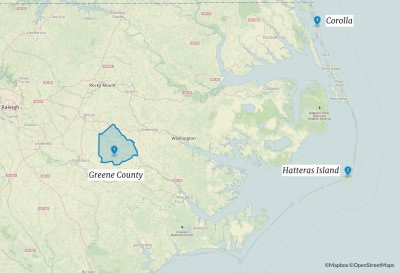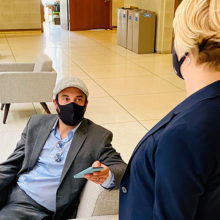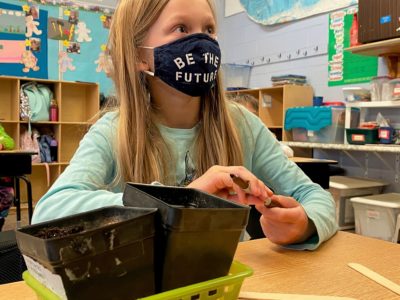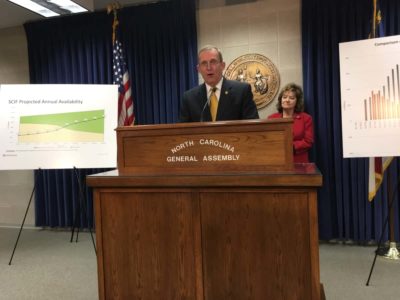
North Carolina schools are in the midst of a technological transformation. The state has signaled its desire to move all schools to virtual textbooks, and legislation this session seeks to further smooth the transition. But at least one school system is way ahead of its peers when it comes to implementing digital information with classroom practices.
Greene County is 12 years into a one-to-one digital device program that has revolutionized the way it does education. If you’re counting back, you’ll note that when officials in that county started their experiment neither iPhones nor iPads existed. They began with old Macbook laptops that they gave out to students and teachers.
 Patrick Miller, superintendent of the school system, says when they began the transition they quickly learned some lessons.
Patrick Miller, superintendent of the school system, says when they began the transition they quickly learned some lessons.
“At first, like anything, when you first introduce something, it made a big difference,” he said.
But those initial gains were temporary.
“We quickly learned that the technology in and of itself wasn’t a silver bullet,” he said. “It’s just a tool.”
The idea to start this digital reform began in 2001. It revolved around a three-pillar approach to reforming the school system. Technology was one pillar. The other two were literacy, and comprehensive counseling and college access.
The technology piece of the program was implemented in full force in the fall of 2003.
While Miller admits it’s debatable, he said at the time Greene County was considered by some to be the first county in the country to implement a one-to-one program in grades 6 through 12 throughout an entire district. Of course that only affected two out the four schools that existed at the time. Now it has six schools, a pre-k center and an alternative education center.
The district spent a lot of time building up its wireless network and instructing teachers on the use of technology in the classroom. Now, in addition to the one-to-one program, instructors have digital document cameras and smart boards if they want them. The high school has a digital video lab where they use equipment that wouldn’t be out of place on a Hollywood movie set.
“This is the end of the 12th year, and there are so many more districts out there with the one-to-one that we’re almost the great forgotten school district,” Miller said. “And that’s ok.”
To pay for this digital transformation, officials had to go through the budget line item by line item and figure out a way to shift funds. For example, they might reallocate textbook money for the digital program with the understanding that online resources would replace some of the old analog ones.
“It’s super expensive. And I tell you when we started, you never can foresee down the road how economic conditions are going to change,” Miller said.
Miller became superintendent in 2008, a fateful year for the nation’s economy. The school system’s budget has declined every year since. Greene County schools leases its equipment from Apple, giving about $900,000 a year to the tech giant. With the decline in budget, Miller says that lease has become burdensome. Without the lease, that money could be used in the school system’s other needy areas, but he doesn’t like to think in those terms.
“To look at it that way would also rob our children of a chance to be prepared,” he said.
The improvement in technology, along with an increased focus on literacy and college counseling has yielded a transformation in the school district.
Historically, Miller says only 25 percent of the school’s population goes on to college. By the mid 2000s, that percentage was in the low 70s. With the help of the College for Everyone program, piloted by then-presidential candidate John Edwards in Greene County, that percentage jumped to 94 in 2008, the third and final year of the program. But Miller said that the percentage of students going to college has stayed high — hovering around mid-80 percent.
Another area where Greene County schools have excelled is in reducing the drop-out rate. When Miller took over in 2008, 63 kids had dropped out that year, for a rate over 6 percent.
The following year, that number plunged to 45 students. Then 39. 25. 21. 18. And this past year, only 15 students dropped out, for a rate of 1.46 percent.
The strategy is simple. The school system gets a list of seniors eligible for graduation but who are struggling. Then officials meet with them, their families and teachers and tries to find out what they can do to help.
“There is no substitute for individual attention,” Miller said.
For the past two years, the graduation rate in the district has been strong at 87 percent.
There is more to the story of Greene County, but just looking over a few progress points in the past decade-plus, it becomes evident that the school system is doing something right. And its foray into the digital technology world is one that the state as a whole and other districts should look to when working on their own integration of digital technology.
Located near East Carolina University, Greene County’s main industry is agriculture. About 80 percent of its population are free-and-reduced price lunch students. Needless to say, the district doesn’t have a whole lot of money to make things happen. Miller is hopeful that as the state transitions to digital learning, it will provide Greene County the resources it needs to keep moving forward.
“Where a more affluent district might be able to pick up the slack, we’re just not able to do that here,” he said.
Time will tell what happens with digital learning in Greene County, but whatever the future holds, the schools in the district have given their students a considerable advantage to help them launch their lives.
Go here to see a video on the Apple website about Greene County Schools.




